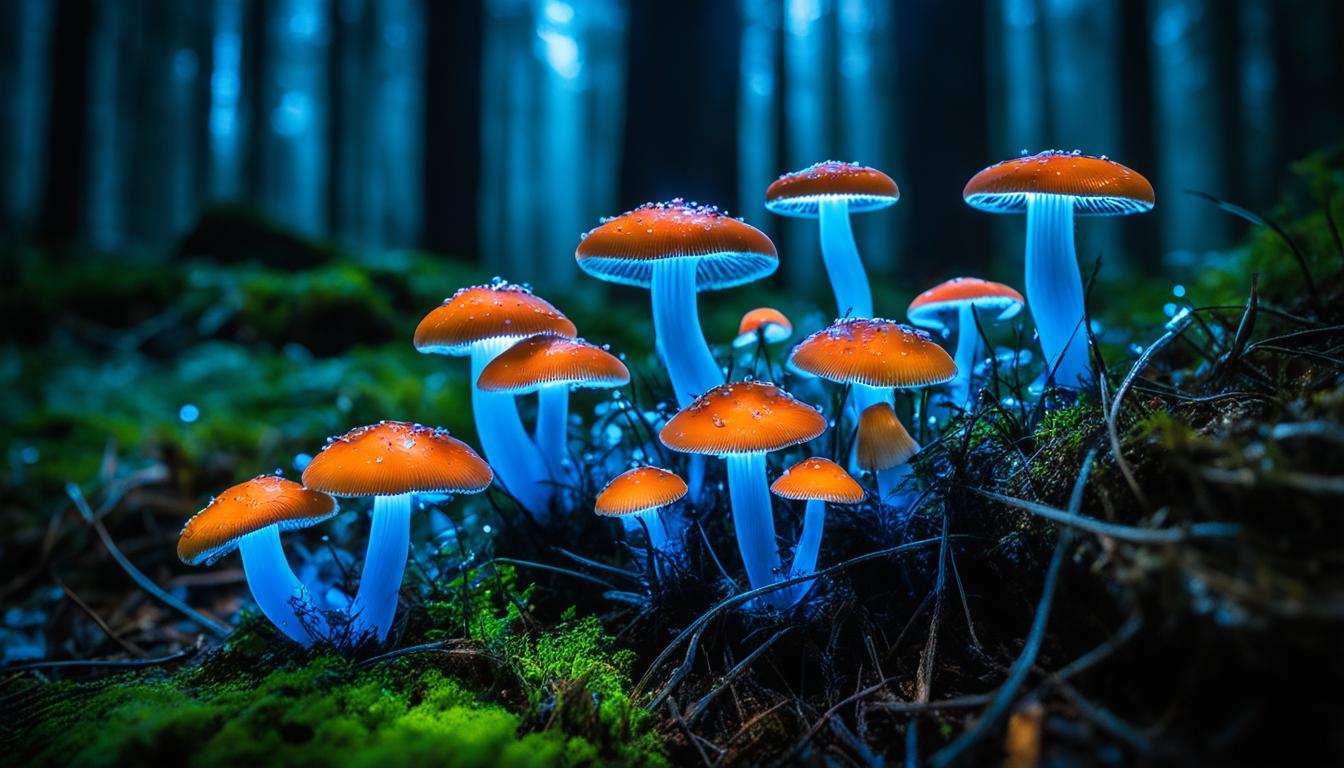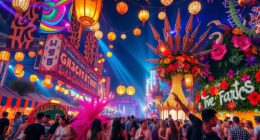Did you know that finding bioluminescent mushrooms can be tough? About 85-90% of nature fans don’t find them. These glowing wonders attract both adventurers and scientists. Mycena mushrooms are famous for this, making up nearly half of these glowing fungi. Their hidden nature makes each discovery exciting. When you search for them at night, you’ll see how they light up the dark woods. You’re about to learn how they glow, where to find them, and about the special kinds that exist.
Key Takeaways
- 85-90% of searches for bioluminescent mushrooms can end in disappointment.
- Mycena mushrooms make up nearly half of all documented bioluminescent fungi.
- Unidentified bioluminescent mushrooms can be found in various locations in Malaysia.
- Environmental conditions greatly influence the intensity of mushroom bioluminescence.
- Bioluminescent mushrooms play an important role in attracting insects for spore dispersal.
The Fascinating World of Bioluminescent Mushrooms
Bioluminescent fungi light up the dark with a magical glow that captures our imagination. These mushrooms have been around for over 1.5 billion years. They stand out as a unique kingdom, different from animals and plants. About 80 species can glow, creating a beautiful sight that has both ecological and cultural importance.
These glowing fungi live in places from tropical rainforests to cold woodlands. Their soft green light attracts insects, helping spread their spores. This smart trick isn’t just about reproduction. It also helps the ecosystem they live in.
Scientists are curious about the glow from mushrooms like the Mycena chlorophos and Omphalotus olearius. They’re exploring how this natural light could be used for eco-friendly lighting. Across the ages, many cultures have told stories about these glowing mushrooms, adding mystery to them.
Despite their captivating glow, these mushrooms need our help. Their survival is at risk due to losing homes and pollution. We need to protect their habitats so future generations can see their magical light.
What Are Bioluminescent Mushrooms?
Bioluminescent mushrooms are a fascinating part of the fungal world. The definition of bioluminescent mushrooms talks about fungi that glow. They can shine in beautiful green or blue colors. This magical light comes from a chemical reaction. It uses luciferins and special enzymes, similar to what makes fireflies glow.
There are over 120 species of glow-in-the-dark fungi. They come in different shapes and colors. These glowing mushrooms fascinate both scientists and nature lovers. They stay hidden in forests but glow brightly at night. Their glow is dimmed by daylight but stands out in darkness.
Scientists think these glowing mushrooms play an important role in nature. They believe the mushrooms attract night-time insects. This helps the mushrooms spread their spores. Some mushrooms can even adjust their glowing to be more efficient at night.
The exact reasons why these mushrooms glow are still being explored. But, the magic and mystery of characteristics of glowing fungi keep everyone curious.
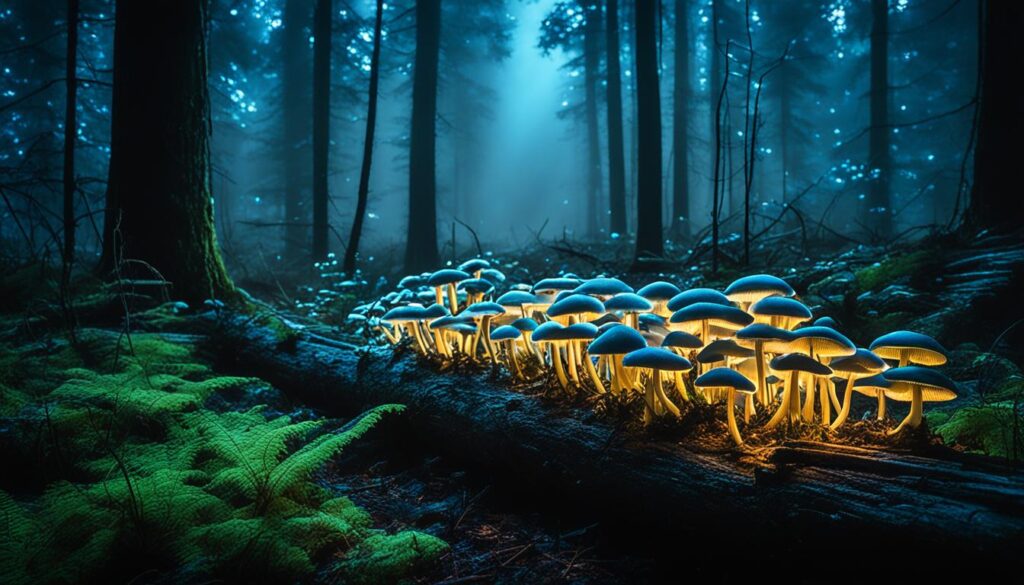
| Characteristic | Description |
|---|---|
| Species Count | Over 120 known species in the order Agaricales |
| Glow Color | Primarily green to bluish-green light at 520–530 nm |
| Ecological Function | Attracts nocturnal insects for spore dispersal |
| Distribution | Found globally, most notably Armillaria mellea |
| Active Bioluminescence | Can glow continuously if conditions are favorable |
The Science Behind the Glow
Bioluminescent mushrooms shine thanks to chemicals called luciferins. When they react with oxygen, light is produced. This amazing bioluminescence process draws in insects to help spread spores.
Understanding Luciferin and Oxyluciferin
In 2015, scientists found how vital oxyluciferin is for fungi to glow. It forms when luciferin reacts with oxygen. Take the Neonothopanus gardneri mushroom in Brazil, for example. It glows bright in young palm areas.
This reaction between luciferin and oxyluciferin isn’t just interesting. It’s crucial for forests. The glow of these mushrooms does more than enchant us. It lights up the night for insects, helping spread spores. This is key for our planet’s carbon cycle.
Experts are digging into the genetics of mushroom glow. They’re looking at how luciferin works with the fungi’s natural rhythms. Studies show these mushrooms have a special clock. It helps them glow at the perfect time to attract insect buddies.
| Aspect | Details |
|---|---|
| Species Count | Only 71 out of 100,000+ fungal species are bioluminescent. |
| Notable Species | Neonothopanus gardneri is one of the brightest, found in Brazil. |
| Glow Control | Mushrooms utilize a circadian clock, glowing optimally at night. |
| Insect Attraction | Experiments show glowing mushrooms attract over three times more insects. |
| Environmental Role | Vital for dispersing spores and aiding the carbon cycle. |
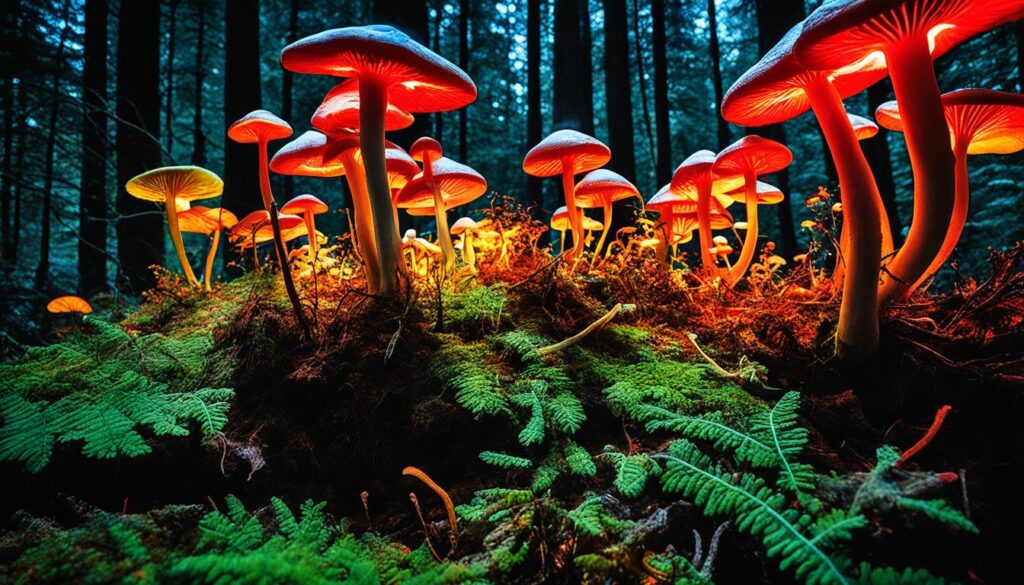
Where to Find Bioluminescent Mushrooms
Looking for bioluminescent mushrooms is an exciting adventure. There are many places where you can find these amazing glowing fungi. The Atlantic Forest of Brazil is famous for its rich variety of life, including glowing mushrooms. Here, mushrooms like Mycena lucentipes glow in beautiful neon-green colors at night. You can join tours at IPBio led by experts to see this magical glow.
Exploring the Atlantic Forest of Brazil
The Atlantic Forest is stunning and home to unique glowing fungi. It’s an old forest with thick plants and a wet climate. Perfect for these mysterious mushrooms. There are tours to preserved areas. Here, you can see the mushrooms glow, especially in the warm months.
Notable Locations Worldwide
But it’s not just the Atlantic Forest. Glowing mushrooms are found in many places around the world. These include:
- Tropical rainforests of Vietnam
- Appalachian Mountains in the United States where Omphalotus olearius thrives
- Southeast Asia, including parts of Indonesia
- Australia’s lush rainforests
- Various temperate zones across Europe and South Africa
In these places, each mushroom species has its own glow. Join local mushroom hunting groups to forage responsibly. It’s a safe way to explore and understand these natural marvels. Enjoy the adventure and the beauty of bioluminescent mushrooms around the world.
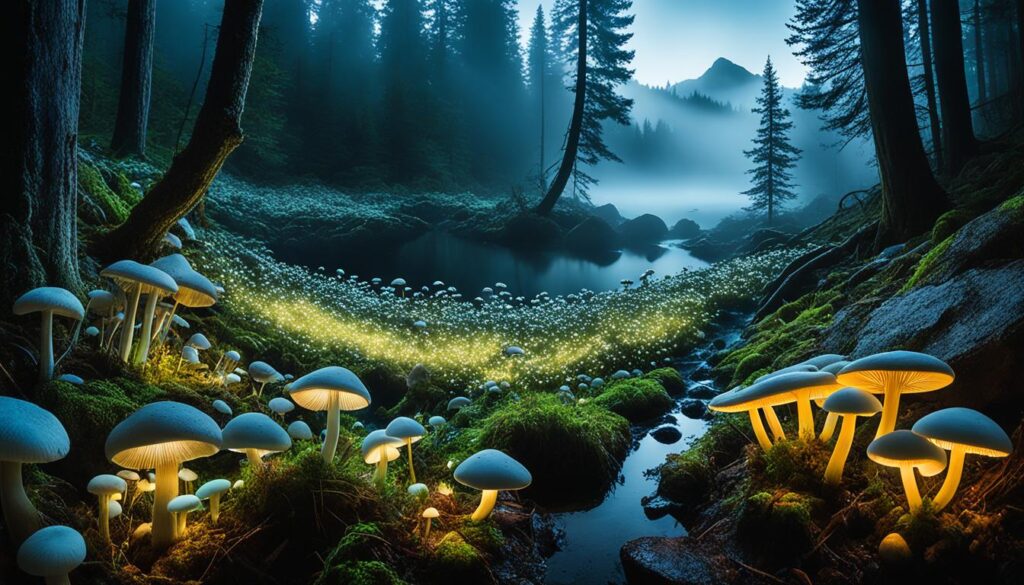
Discovering Unique Species of Glowing Fungi
Exploring bioluminescent fungi opens up a world full of unique species. Mycena lucentipes is notable for its bright glow at night. It grows on decaying wood and offers a stunning view in its natural setting.
Mycena lucentipes
Mycena lucentipes emits a strong light that draws people in. It lives mostly in forests, shining so brightly it can be seen from afar. This light helps attract insects, which spread its spores. This is important for the mushroom’s growth and survival.
Roridomyces sp. – The Caramel Glow
Roridomyces sp. is known for its unique caramel-colored glow. Its light is mostly seen at the mushroom’s base, creating a magical sight. These features are not just for show. They play a key role in the mushroom’s life cycle and its ability to thrive.
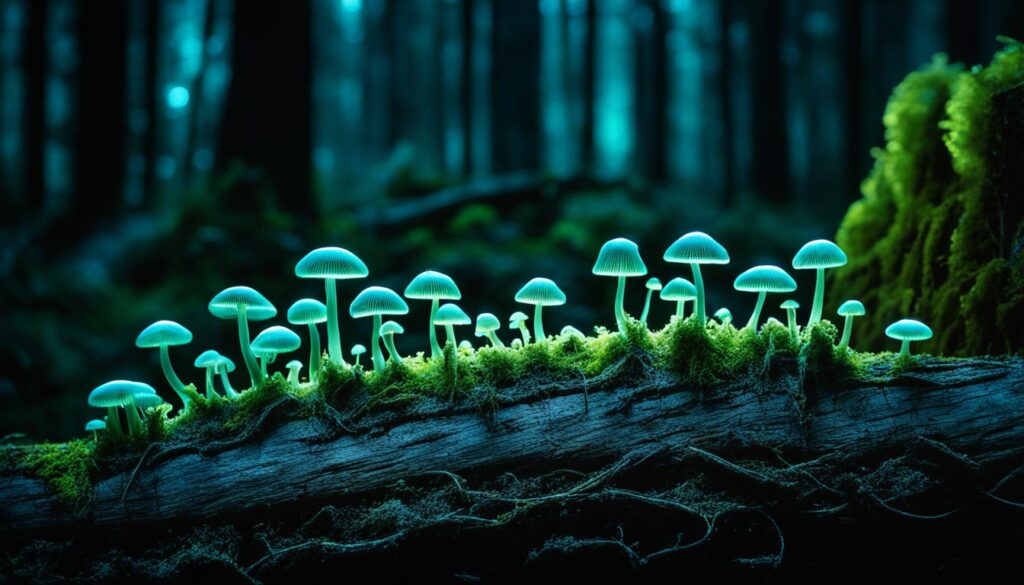
Ecotourism and the Conservation of Bioluminescent Mushrooms
Ecotourism is key to conserving bioluminescent mushrooms. By going on eco-friendly tours, you help protect these ecosystems. You get to see nature’s marvels. Tours also fund vital conservation work.
How Eco-tours Preserve Natural Habitats
The Caiman Eco-Lodge in the Amazon rainforest focuses on sustainable tourism. Its tours highlight the vital role of fungi in nature. Mushrooms indicate the health of their environment, showing why they’re essential.
The lodge offers experiences to enhance your understanding of the rainforest. You can explore the variety of fungi on guided tours. There are also culinary events with local mushrooms, and workshops on eco-conservation.
By joining these tours, you support eco-friendly lodging and responsible travel. This helps keep the rainforest and its diverse life safe. It’s crucial for protecting glowing mushrooms and all rainforest biodiversity.
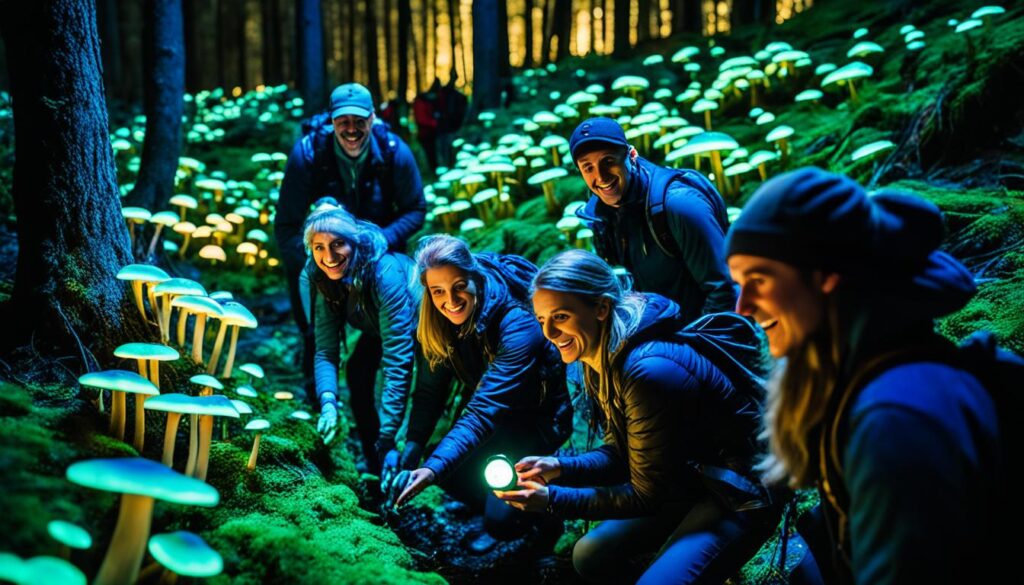
Photographing Bioluminescent Mushrooms
Capturing the light of bioluminescent mushrooms is a unique challenge in photography. It combines technical skills with a lot of patience. To succeed, here are some tips designed for photographing these glowing mushrooms.
Techniques for Capturing the Glow
Getting the right photo of these glowing fungi is about knowing your camera. Here’s what you need to do:
- Use long exposure photography to catch enough light. This usually means more than 20 seconds.
- Keep your ISO between 1250 and 1600 to get the best sensitivity.
- Choose your f-stop based on how big your subject is. Smaller apertures, like f/2.8, are better in the dark.
- Use a tripod to keep the camera still for sharp photos.
- To avoid shaking the camera, use a remote shutter or a delay timer.
- Try different focal lengths. Wide-angle lenses under 20mm are good for capturing the scene around.
- A macro lens between 35-105mm helps with close-up shots.
- Turn on a low noise filter to keep the image clear and reduce grain.
Remember, light from cities can ruin your mushroom photos. Go to darker places with less artificial light for the best shots of their amazing glow.
| Camera Settings Example | Subject | Exposure Time |
|---|---|---|
| Mycena roseoflava | ISO 1000, f/2.8 | 8 min |
| Filoboletus manipularis | ISO 1250, f/5.6 | 3 min |
It’s important to respect where the mushrooms grow. Stay on paths, don’t touch the mushrooms, and keep the place clean. Some mushrooms are poisonous, so picking them can hurt you and their home. By being careful, you can get better at this kind of photography. Then, you can capture these amazing glowing mushrooms.
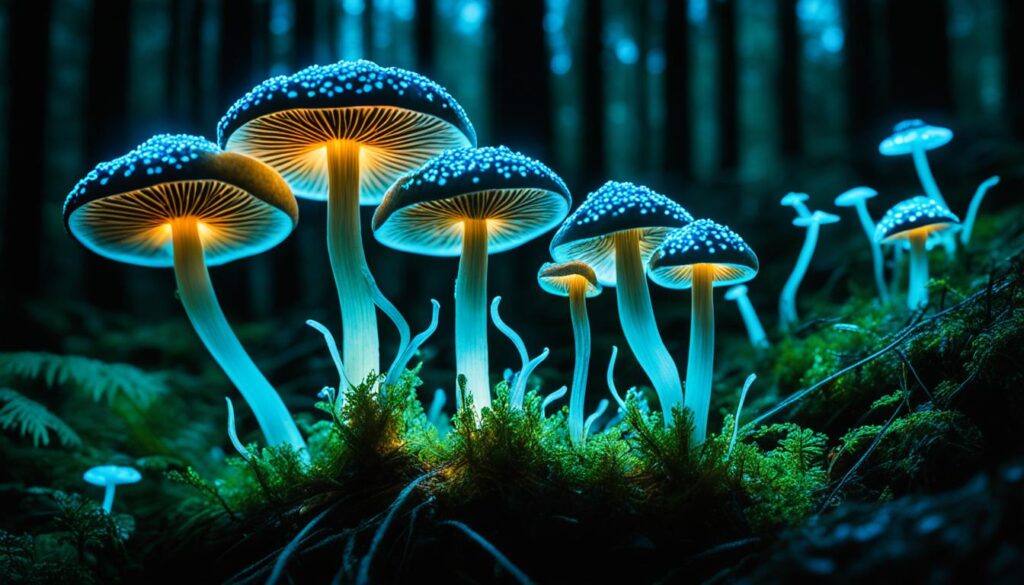
The Role of Bioluminescent Mushrooms in Ecosystems
Bioluminescent mushrooms are key players in their ecosystems. They attract insects, which is crucial for spreading their spores. Their glow not only adds beauty but is vital for survival. This glow, with its low wavelengths, draws in various insects. Dipteran flies are especially attracted, helping spread the mushrooms’ spores.
Attracting Insects for Spore Distribution
Understanding the role of these mushrooms grows as we delve into research. A study in Costa Rica found traps that mimic their glow caught more insects than those that didn’t glow. This shows that the light is key in attracting insects. Another study from Sao Paulo University in Brazil noticed more flying insects around glowing mushrooms. This highlights the mushrooms’ role in increasing biodiversity via successful spore spread.
These glowing mushrooms do more than light up forests. They also help maintain soil health. By understanding their part in natural habitats, we see they are crucial for ecological balance. Their interactions reveal the important role they play. This captures the interest of both nature lovers and researchers.

